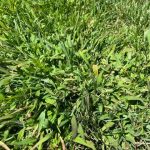
Brown patches in your lawn can be as unwelcome as an unexpected guest at a dinner party. They disrupt the lush greenery and detract from the beauty of your outdoor space. At Erbert Lawns, we understand the frustrations that brown patches on your lawn can bring. These unsightly spots can mar the beauty of your green space, but don’t worry restoring your lawn’s lush, vibrant look is achievable. In this guide, we’ll navigate through effective methods to rejuvenate those brown areas, ensuring a healthy, thriving lawn.
Key Takeaways
- Identification: Recognize the cause of brown patches for effective treatment.
- Proper Watering: Overwatering or underwatering can contribute to brown patches.
- Regular Maintenance: Regular mowing, aeration, and fertilization are crucial.
- Fungicide Use: Use fungicides correctly if brown patches are due to fungal issues.
- Consult Professionals: Sometimes, expert advice is needed to tackle persistent lawn issues.
Understanding Brown Patches
Brown patches can appear for various reasons including fungal diseases, pest infestations, improper watering, or even nutrient deficiencies. Identifying the underlying cause is the first step in healing your lawn. We offer in our about us section, where you can learn more about our commitment to healthy, beautiful lawns. For instance, if the patches are due to fungal diseases like Rhizoctonia, considering a fungicide might be necessary.
Proper Lawn Care Techniques
Regular Maintenance
Maintaining your lawn involves several routine activities which prevent and remedy brown spots:
- Mowing: Keep your grass at an ideal height based on its type.
- Watering: Provide your lawn with 1 to 1.5 inches of water per week, preferably in the morning.
- Aeration: This helps alleviate soil compaction, allowing roots to breathe.
- Fertilization: Use the right fertilizer for your specific type of grass and soil needs.
Advanced Solutions
If routine care isn’t solving the issue, it might be time to look into more specific solutions like:
- Soil Testing: Sometimes, the problem is with the pH level or the nutrient content of the soil. Soil tests can reveal a lot about what your lawn needs.
- Reseeding: For severe damage, planting new grass might be necessary. Choosing the right seed mix can make a difference in prevention. For guidance on these advanced techniques, consider visiting University of Minnesota Extension for soil management and health.
Deep Dive Into Lawn Health
Understanding the Root Causes
Before taking any action, it’s essential to understand what’s causing the brown patches on your lawn. There are several potential culprits:
- Fungal Diseases: Such as brown patch or dollar spot, which thrive in moist conditions.
- Insect Damage: Certain pests like grubs and chinch bugs feed on grass roots and can cause widespread damage.
- Water Issues: Both overwatering and underwatering your lawn can lead to brown spots.
- Nutrient Imbalances: Poor soil fertility or incorrect pH levels can prevent grass from absorbing essential nutrients.
- Physical Damage: Heavy foot traffic or mowing with dull blades can stress and damage the grass.
Strategic Solutions to Lawn Recovery
After identifying the problem, the next step is applying the correct solutions. Here are some strategic approaches:
- Adjusting Water Habits: It’s crucial to balance the amount of water your lawn receives. Install a simple rain gauge to measure water intake and ensure that your lawn is receiving the recommended amount. Lawn sprinkler systems should be checked and adjusted regularly to avoid overwatering.
- Pest and Disease Management: If pests or diseases are the issue, it may be necessary to apply treatments:
- Pesticides: Use them sparingly and choose eco-friendly options when possible. Always follow the label instructions for application.
- Fungicides: These are essential if a fungal disease is diagnosed. Reapply as needed, particularly during wet weather conditions when fungus thrives.
- Soil Care: Conducting a soil test is a proactive step to ensure that your soil has the right conditions for healthy grass growth. This test can help you understand if you need to adjust pH levels or add specific nutrients.
- Aeration and Overseeding: Aerating your lawn can help relieve soil compaction, allowing roots to expand and absorb more nutrients and water. Overseeding soon after aerating can help fill in bald spots and increase turf density.
Preventive Measures for Future Health
- Regular Monitoring: Keep a close eye on your lawn’s health through the seasons. Changes in color or texture can be early indicators of potential issues.
- Proper Mowing Techniques: Mow your lawn at the recommended height for your specific grass type. Sharp mower blades make clean cuts that heal quickly and resist diseases.
- Seasonal Fertilization: Tailor your fertilization strategy to the needs of your lawn throughout the year. Use products that complement the growing conditions and developmental stage of your grass. Effective lawn fertilization is crucial for promoting lush, vigorous growth and enhancing your lawn’s resistance to diseases and pests.
Cultural Practices to Enhance Lawn Resilience
Cultural practices are everyday actions that enhance the overall health and resilience of your lawn:
- Diverse Grass Selection: Plant a mixture of grass types suited to your climate. This diversity can reduce pest and disease impact and lead to a more robust lawn.
- Stress Reduction: Avoid creating stress for your grass with excessive foot traffic and heavy equipment. Designate pathways and encourage their use.
- Educational Resources: Stay informed about the latest in lawn care by following blogs and resources that focus on sustainable gardening practices.
By adopting these comprehensive care strategies, you ensure that your lawn remains not only beautiful but also healthy and strong. Remember, the key to preventing brown patches and maintaining an enviable lawn lies in regular care, quick action on potential threats, and a commitment to sustainable practices. At Erbert Lawns, we are dedicated to the future of lawn care, embracing innovative techniques that promote long-term health and sustainability. Our proactive approach ensures that your lawn can withstand the challenges of today and thrive in the future.
Conclusion
Revitalizing your lawn requires a blend of proper care, routine maintenance, and sometimes professional advice. If you’re struggling with persistent brown patches, Contact Erbert Lawns. We’re here to help restore your lawn to its natural beauty, ensuring it remains a lush, inviting space.
Frequently Asked Question:
Q1: What causes brown patches on lawns?
Brown patches can be caused by fungal diseases, pest damage, drought stress, or nutrient deficiencies.
Q2: How often should I water my lawn to avoid brown patches?
Generally, your lawn needs about 1 to 1.5 inches of water per week, either from rainfall or watering.
Q3: Is it necessary to use fungicides to treat brown patches?
If a fungal disease is confirmed, fungicides can be necessary. Always follow the label for proper application.
Q4: Can improper mowing contribute to brown patches?
Yes, cutting grass too short can stress it, making it susceptible to diseases and brown patches.
Q5: How can I tell if my lawn needs aeration?
If the soil is compacted and water stands on the grass, aeration might be necessary to improve soil condition.
Q6: Should I consult a professional for lawn treatment?
Consulting a professional like Erbert Lawns can provide tailored solutions for your specific lawn issues.









